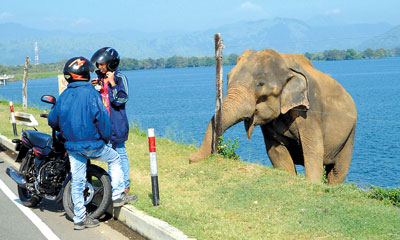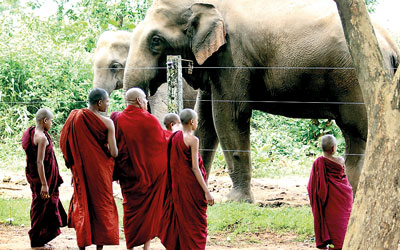Wild elephants, people and an electric fence
Elephants are creatures of habit but are also clever animals that learn from experience, as shown by this story of elephants at the Uda Walawe National Park electric fence along the Timbolketitya – Thanamalwila road.
Initially there was only one elephant that came to the electric fence to be fed. That was in the late 1990s. Expert elephant researcher Dr. Prithiviraj Fernando, based on a study on these ‘fence elephants’ over the past eight years, has identified 64 different elephants, all males, which came to the fence. They were fed by passersby, who stopped and gave them fruit, mainly bananas, mangoes and water melon, purchased from the fruit stalls put up by villagers along the road. Those who fed them mostly consisted of the ‘general public’ -people in buses, three wheelers and motor bikes going to Kataragama on pilgrimage and lorry drivers transporting produce along the road, but few of the ‘Colombo crowd’ who frequent National Parks in their fancy four wheel drive vehicles. A notable addition was the President who also once stopped on his way, to give an offering to the fence elephants as reported in the media.

Friendly reality: Rambo waits at the slope for his goodies. Pic by Sudath Abeysinghe
Dr. Fernando says some of these elephants come to the fence regularly, some occasionally and others just once or twice in the period of study. If an elephant did not get fed on any day he did not visit the fence for a couple of days. If one got fed today, it was more likely to come the next day as well. Once they came to the fence, the elephants waited for an hour or two and if not fed, went back to the jungle. If they got food, they stayed on.
Individual elephants had a general area of the fence they frequented but did not have particular spots that they defended against others. They varied in their level of tolerance of other elephants sharing the food. Some did not mind others getting fed at the same spot while a few dominant individuals grabbed most of what was given. Most elephants tolerated other elephants sharing a ‘feeding location’ with some individuals striking up regular alliances. All the elephants went back into the Park in the night and fed on natural vegetation. Analysing the droppings of fence elephants showed that none of them depended solely on the food provided by people.
This unique interaction of elephants and people ended in 2012. The Department of Wildlife Conservation, in its infinite wisdom, and egged on by the ‘Colombo crowd’ decided to erect another fence 50 metres inside the park to prevent people feeding the elephants. The elephants that would come to the fence over the years did not harm anyone nor did they attempt to break the fence and come out. The people gave the food willingly and the elephants were happy to accept what was given. A few elephants broke the fence but even then those individuals never stayed at the fence during the day. The fence breakers stayed inside the Park during day time, broke the fence at night, passed by the fruit stalls and went and raided the sugar cane and paddy fields beyond. In the morning they broke the fence again and went back into the park.
However, after the second fence was erected the situation changed drastically. The fence elephants also started breaking through both the fences and some started raiding the fruit stalls. The DWC spent a lot of effort ‘chasing’ these elephants with fire crackers and shooting at them. The Sevanagala Sugar Company had to start patrolling the fences throughout the night by driving along the fences in tractors with spotlights, to prevent the elephants raiding the sugar cane plantation. Elephants have now also started regularly breaking the fences along the sides of the Park away from the road and entering the surrounding villages, breaking houses and raiding crops. So the second fence resulted in stopping the friendly interaction between people and elephants and converting it into a human-elephant conflict situation.

A group of Buddhist monks stop to see the elephants. Pic by Prithiviraj Fernando
It is very significant that the elephants that came almost daily to the fence, did not come to the fence to get their daily requirement of food, which is about 150-300 kg of green matter. Maybe they also came to look at the humans as much as the humans who stopped to look at the elephants. The photograph above is of one of the fence elephants who now comes along the steep grassy slope between the main road and the Walawe reservoir and continues to ‘meet the people’ who also continue to stop and give him a few bananas.
Popularly known as ‘Rambo’, he was the first individual who started this activity in the late 90s. Amazingly he is also the ‘last man standing’ at the fence. This clever elephant now has got one up on the DWC. When the DWC officers come and throw fire crackers at him on the dam, he gets into the water. He has figured out that the fire crackers go out when they hit the water! He waits them out half submerged and once the DWC officers go back, with a disparaging chuckle he returns to his station to continue the friendly meeting of two species across the fence.
Follow @timesonlinelk
comments powered by Disqus


